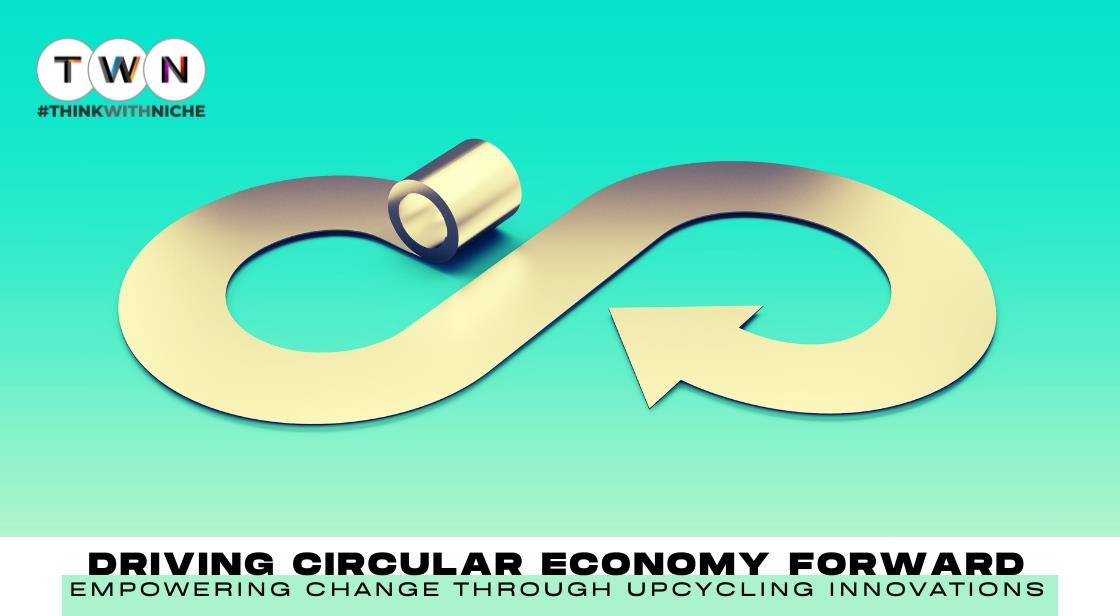Driving Circular Economy Forward: Empowering Change through Upcycling Innovations

Blog Post
Welcome, change-makers and eco-warriors! Today we're diving into a journey, exploring the revolutionary concept that is driving the circular economy forward - Upcycling Innovations.
This transformative power is not just about reusing waste; it's about creating valuable resources that foster a sustainable and efficient economy.
From discarded materials to high-value products, we're witnessing a green revolution unlike any other. This is a celebration of creativity, innovation, and sustainability.
So, buckle up, and prepare to be inspired by the possibilities that lie within our waste bins.
"The world is changed by your example, not by your opinion." - Paulo Coelho
In this article, we look at the driving forces behind this shift towards a greener future, and how each one of us can play a role in empowering this change.
Discover the transformative power of upcycling innovations, and how they are revolutionizing the concept of circular economy.
Dive deep into the world of sustainable change, where waste is transformed into valuable resources and our future is shaped by sustainable and efficient economic strategies.
Welcome to a greener future, where trash is no longer considered waste, but a valuable resource. Welcome to the world of upcycling.
Here, we will take you on a journey exploring the driving forces, transformative power, and the groundbreaking innovations in upcycling that are revolutionizing the concept of the circular economy.
Driving Circular Economy Forward: Empowering Change through Upcycling Innovations
Driving Forces: What is pushing societies towards upcycling and a circular economy? We delve into the environmental, societal and economic factors that are catalyzing this shift.
Transformative Power: Uncover the transformative potential of upcycling in creating not just a more sustainable economy, but also a more efficient one.
Innovations: From turning plastic into wearable fashion to transforming food waste into energy, get inspired by the game-changing upcycling innovations around the globe.
Join us as we explore how upcycling is not just recycling's trendier cousin, but a powerful tool to empower sustainable change, drive the circular economy forward and create a greener, more sustainable future.
From Waste to Wealth:
The Power of Upcycling in Circular Economy we had a heart-to-heart about trash. Mountains of waste are not only unsightly; they're a clear sign that our current economic model is unsustainable. But what if we could turn that waste into wealth?
Enter the concept of upcycling. This is not your grandma's recycling — it's an innovative process that transforms waste materials into products of better quality or higher environmental value. It's like the fairy godmother of the circular economy, turning our old, discarded 'pumpkins' into sparkling, sustainable 'carriages.'
"Upcycling is the process of transforming waste materials or useless products into new materials or products of better quality or for better environmental value."
-
Upcycling: Closing the Loop
Upcycling is all about closing the loop in product life cycles. Instead of being tossed in a landfill, materials are reimagined, repurposed, and given a second chance to shine. It's not just beneficial for the environment; it's also a driver of economic growth.
Let's take a moment to digest that. Waste - something we usually discard without a second thought - can be a valuable resource. It's a radical shift in thinking, but one that's gaining traction worldwide.
-
Driving a Sustainable Future
Upcycling is more than a trend; it's a catalyst for change. It's challenging our throw-away culture and pushing us towards a more sustainable future. And the best part? We're all invited to be a part of this revolution.
From innovative start-ups to forward-thinking individuals, people are embracing upcycling and finding creative ways to give waste a new lease on life. It's a testament to human ingenuity and our ability to adapt in the face of challenges.
-
Transforming the Economy, One Upcycle at a Time
Upcycling is not just about transforming waste; it's about transforming our economy. By closing the loop and turning waste into wealth, we're paving the way for a circular economy - an economic system designed to eliminate waste and the continual use of resources.
It's a bold vision, but one that's within our reach. Through upcycling innovations, we're proving that it's possible to create a sustainable, efficient economy that benefits everyone. And that, my friends, is a change worth driving forward.
-
Transforming Trash into Treasure: The Art and Science of Upcycling
Imagine a world where waste doesn't exist. Where every old, discarded item gets a new lease of life, transformed into something useful, even beautiful. Welcome to the realm of upcycling.
Upcycling is the art and science of converting waste materials into products of higher quality and environmental value. It's a revolutionary concept that is literally turning trash into treasure, pushing forward the circular economy.
This innovative process is far more than a trendy buzzword. It's a transformative movement that is disrupting traditional production-consumption systems, turning them on their heads. And the beauty of it lies not just in its environmental impact, but also in its endless possibilities for creativity and innovation.
-
Unleashing Creativity: A New Aesthetic Revolution
Upcycling is as much about creativity as it is about sustainability. It's a process that encourages people to look at old, discarded items in a new light, to see potential where others see waste. This sparks a level of innovation and creativity that is genuinely transformative.
In this way, upcycling is driving a whole new aesthetic revolution. It's breathing new life into items that would otherwise end up in a landfill, from old furniture and clothing to electronic waste. The results are often stunningly beautiful and entirely unique.
-
The Science behind the Art: Promoting a Circular Economy
"The circular economy is an economic system aimed at eliminating waste and the continual use of resources."
But the benefits of upcycling go beyond aesthetics. The process plays an essential role in promoting a circular economy – a system designed to eliminate waste and continuously reuse resources. Upcycling fits perfectly within this system, turning waste into valuable products and reducing the need for new materials.
Through upcycling, we can cut down on waste, reduce our carbon footprint, conserve natural resources, and stimulate sustainable economic growth. The science behind upcycling is as compelling as the art it produces, and together, they're driving us towards a more sustainable future.
-
Empowering Change: A Greener, More Sustainable Future
Upcycling isn't just an innovative solution for waste management; it's a powerful tool for social change. By upcycling, individuals, businesses, and communities can make a tangible difference in the fight against climate change and the push towards sustainability.
But the potential of upcycling extends even further. It's a movement that empowers people, giving them the tools and knowledge to create, innovate, and make a positive impact on the world. It's not just about transforming trash into treasure; it's about transforming the way we think about waste, resources, and the future of our planet.
-
Upcycling as a Sustainable Business Model: Opportunities and Challenges
Ever thought about how that old tire could become a chic, outdoor ottoman? Or how discarded wood pallets could transform into a rustic coffee table? Welcome to the world of upcycling, a powerful catalyst in the circular economy, driving sustainable change by turning waste into valuable, reusable resources.
Businesses worldwide are beginning to recognize upcycling's untapped potential. This innovative approach not only promotes sustainability but also unlocks a new avenue for creativity and profitability. But, like any transformative movement, it comes with its own set of challenges and opportunities.
-
Opportunities in Upcycling
At its core, upcycling redefines waste as an asset, a raw material with immense potential. This paradigm shift opens up a treasure trove of opportunities.
Creative Innovation: Upcycling encourages businesses to think outside the box, innovating with materials that were previously regarded as waste.
Cost Efficiency: By utilizing waste materials, companies can significantly reduce production costs, making upcycling a financially sustainable model.
Sustainable Branding: Businesses embracing upcycling often find it enhances their brand image, attracting eco-conscious consumers and differentiating them in the marketplace.
-
Challenges in Upcycling
Despite its appealing prospect, upcycling isn't without hurdles. It requires a holistic approach and a willingness to tackle some daunting challenges.
Logistical Complexities: Sourcing, collecting, and sorting waste materials can be logistically challenging and labor-intensive.
Scale of Production: Balancing the scale of production with the availability of waste materials can be tricky, potentially limiting growth.
Regulatory Issues: Upcycling businesses may face regulatory hurdles related to health and safety standards, especially when dealing with certain types of waste.
As we navigate these challenges and seize the opportunities, the upcycling revolution is steadily gaining momentum. It's time we embrace this shift towards a greener future, investing in upcycling innovations and driving the circular economy forward.
The Circular Economy Revolution: How Upcycling is Changing the Game
Can you imagine living in a world where nothing goes to waste—where every item discarded finds a new purpose? Welcome to the realm of the circular economy, a revolutionary concept that's shaking up the way we view consumption and waste. At the heart of this game-changing movement is the transformative practice of upcycling.
-
Defining the New Normal: Upcycling
So, what exactly is upcycling? It's a process that takes waste materials and transforms them into products of higher quality or value than the original. The beauty of upcycling lies not only in the innovative repurposing of materials but also in the incredible opportunities it offers for sustainability and efficiency.
By breathing new life into discarded items, upcycling minimizes the need for new raw materials and reduces the energy used in traditional manufacturing processes. This is not just recycling—it's recycling taken to the next level, an approach that redefines waste as a resource, rather than a problem.
Also Read: Sustainability Strategies for Businesses: Tips for Going Green
-
Driving Forces Behind the Upcycling Boom
Upcycling isn't just a trend—it's a movement, driven by a growing awareness of the environmental impact of consumerism and the need for sustainable alternatives. In an era where climate change and resource depletion are pressing concerns, upcycling emerges as a compelling solution, turning the linear "take-make-dispose" model of consumption on its head.
-
What is "take-make-dispose" model of consumption?"
take-make-dispose" model of consumption, often referred to as the linear economy, is the prevailing economic system in our global society. It's a straight line process where resources are taken, products are made, and after use, they are disposed of as waste. This model tends to deplete resources, create environmental pollution, and generate substantial waste, thereby pushing us towards an unsustainable future.
-
Shifting Paradigms: From Linear to Circular
As we face the consequences of the linear economy, a transformative solution is emerging in the form of the circular economy. This model focuses on keeping resources in use for as long as possible, extracting maximum value out of them, and then recovering and regenerating products and materials at the end of their life. It's a closed-loop system that reduces waste, conserves resources, and promotes sustainability.
"The traditional linear economy model of take-make-dispose is unsustainable and contributes to environmental degradation."
-
Driving Circular Economy Forward: The Role of Upcycling
Upcycling, the process of transforming waste or useless materials into new products of better quality and environmental value, is a key driver of the circular economy. By giving new life to waste, upcycling not only minimizes the volume of discarded materials and waste, but it also reduces the need for new production and thus saves resources. It's a revolutionary concept that is pushing the boundaries of innovation and sustainability.
But it's not just environmental factors driving this upcycling boom. There's also a growing appreciation for the unique, handcrafted aesthetic that upcycled products offer. From chic furniture made from reclaimed wood to beautiful jewelry crafted from e-waste, upcycled goods embody a fusion of sustainability and style that's resonating with today's conscious consumers.
-
Empowering Change: The Transformative Power of Upcycling
Upcycling stands as a powerful symbol of the circular economy's potential to drive sustainable change. By transforming waste into wealth, upcycling showcases the possibilities for innovation and creativity in pursuing a more sustainable and efficient economy.
The message is clear: with upcycling, we're not just reusing—we're rethinking. We're redefining what it means to consume and to waste, challenging traditional norms and breaking boundaries. In the realm of the circular economy, upcycling isn't just a practice—it's a mindset, a testament to our capacity to innovate for a greener, more sustainable future.
Creative Upcycling Solutions for a Greener Future
Imagine a world where waste isn't just waste, but a treasure trove of valuable resources. This is no utopian dream. Rather, it's a vivid reality being shaped by upcycling innovations, breathing new life into what we once deemed useless.
Upcycling - the process of transforming waste materials into higher quality, more useful products - is revolutionizing the circular economy. It's not just about being eco-friendly, it's about rethinking our entire approach to production and consumption.
Through creative upcycling solutions, we're not just reducing waste, we're also minimizing the need for raw materials. The result? A greener, more sustainable future that relies less on depleting natural resources and more on the transformative power of innovation.
"Upcycling can reduce waste, conserve resources, and reduce greenhouse gas emissions."
Unleashing the Power of Upcycling
From discarded plastic bottles turned into chic home decor, to repurposed food waste fueling green energy, upcycling is all about seeing potential where others see trash. It's a forward-thinking approach that's shaking up industries, leading towards a more efficient, sustainable economy.
But it's not just about transforming materials. It's also about transforming mindsets. Upcycling is empowering individuals, companies, and even entire communities to make more conscious, sustainable choices.
Driving Change, One Upcycled Product at a Time
What's truly remarkable about upcycling is how it's driving change on a grassroots level. From DIY enthusiasts to big brands, everyone's getting on board the upcycling train. It's a clear sign that we're moving towards a future where every waste product is seen not as an end, but as the beginning of something new and valuable.
As we continue to push the boundaries of upcycling, we're not just reducing our environmental footprint. We're also paving the way for a more sustainable, efficient economy that values resources and minimizes waste. And that's a future worth driving towards.
The Environmental and Social Impacts of Upcycling in Circular Economy
Imagine a world where waste isn't wasted. Rather, it's transformed into a valuable resource, fueling the wheels of the economy and fostering sustainable development. This isn't a utopian fantasy, but a tangible reality being forged by the principles of a circular economy and the transformative power of upcycling.
Upcycling, the art of transforming waste materials into higher quality products, is a driving force behind the circular economy. It's a creative solution to our pressing environmental issues, and it's also a catalyst for empowering social change.
The Environmental Resurgence
Upcycling is revolutionizing the way we view and handle waste. It's not only about reducing landfill mass but also about minimizing the extraction of new resources, thereby preserving our planet's ecological balance.
By giving a second life to used products, upcycling helps in cutting down carbon emissions associated with manufacturing new products. It's a positive step towards combating climate change, with every upcycled item making a significant difference.
"Upcycling can create new business opportunities and jobs in the green economy."
The Social Ripple
But the impact of upcycling goes beyond the environment; it also creates a ripple effect in our society. It promotes a culture of creativity and innovation, empowering individuals and communities to make a difference.
Upcycling also opens avenues for economic empowerment. It sparks entrepreneurship and creates job opportunities, often in marginalized communities, leading to inclusive growth within the circular economy.
Through upcycling, we are not just championing environmental sustainability, but also fostering social inclusion and economic resilience. It's a testament to the transformative power of innovative thinking and the boundless potential of the circular economy.
Collaborative Upcycling: Engaging Communities and Empowering Change
Imagine a world where your trash becomes another's treasure - not in a metaphorical sense, but quite literally. This idea is no longer a far-off dream, thanks to the innovative concept of upcycling. Tearing down the traditional 'make-use-dispose' model of consumption, upcycling is transforming the way we perceive waste - morphing it from a problem into a solution.
Collaborative upcycling is an exciting evolution within this burgeoning sector, and it's causing quite the buzz amongst environmentally conscious communities. It's not just about giving waste a second lease on life - it's about empowering individuals and societies to become active contributors to a more sustainable future.
Transforming Waste Into Worth
Upcycling isn't just about recycling. It's about revaluing - turning something considered as waste into a higher-value product. Whether it's converting discarded plastic bottles into trendy fashion accessories or transforming old wooden pallets into chic furniture, upcycling is all about tapping into our creativity to reduce waste and conserve resources.
Driving a Community- Based Circular Economy
At the heart of collaborative upcycling is the concept of community. Bringing together like-minded individuals, local businesses, and even entire cities, it's about fostering a shared sense of responsibility towards our environment. Through innovative upcycling projects, communities are not just reducing waste, but are also creating jobs, boosting local economies, and fostering stronger, more sustainable societies.
-
Empowering Change Through Innovation
But, what truly sets collaborative upcycling apart is its ability to inspire change. Beyond just repurposing waste, it's about encouraging innovation, challenging traditional consumption patterns, and prompting us to rethink our relationship with waste. By showing us that every piece of waste holds potential value, it empowers us to become active contributors to a more sustainable and circular economy.
So, here's to the transformative power of upcycling - a tool that's not just cleaning up our planet, but is also empowering communities and driving us towards a greener, more sustainable future.
Upcycling and Design: The Interplay between Art and Sustainability
Imagine a world where trash isn't simply discarded but is viewed as a potential treasure trove of resources. That's the principle behind upcycling, a concept that's shaking up the design world and transforming our approach to sustainability. It's not just about recycling; it’s about creating something new and valuable from something old and unwanted.
"Upcycling can contribute to the United Nations Sustainable Development Goals, including responsible consumption and production and climate action."
A New Aesthetic in Design
Upcycling is rapidly becoming a significant trend in art and design. Innovative designers are finding creative ways to reuse materials that might otherwise end up in a landfill. This not only reduces waste but also introduces a unique aesthetic that challenges traditional design norms.
From repurposed wooden pallets transformed into chic furniture pieces, to old tires turned into trendy ottomans, upcycling is redefining the lines between trash and treasure. The result is a more sustainable design process that embraces the charm of the old and the worn, adding a layer of history and narrative to each creation.
Driving Sustainability through Upcycling
At its core, upcycling is about more than just creating trendy designs. It's a powerful tool for driving sustainability and promoting a circular economy. By reimagining the way we use and dispose of materials, we can significantly reduce our environmental impact and move towards a more sustainable future.
Moreover, upcycling encourages us to repurpose instead of replace, which can significantly reduce the demand for new materials and lower our carbon footprint. The transformative power of upcycling lies in its ability to see value where others see waste, turning the ordinary into the extraordinary.
The Future of Upcycling: Emerging Trends and Technologies
When you look at a piece of trash, do you see waste or do you see a potential resource? As it turns out, the future of sustainability just might hinge on how we answer that question. And that's where upcycling comes into play, transforming our 'trash' into something of greater economic value.
The concept of upcycling is far from new, but emerging trends and technologies are putting it in the limelight as a key solution for a sustainable future. Let's dive into what the future might hold for upcycling and how it is reshaping our economy.
Advancements in Upcycling Technologies
Technology is playing a pivotal role in propelling the upcycling movement forward. Innovative machines that can transform plastic waste into fuel, building materials, and even wearable accessories are no longer pipe dreams, they're reality. It's the dawn of a new era where waste is not just reduced, but creatively reinvented.
Internet of Things (IoT) & Upcycling
Imagine a world where your trash bin notifies you when you're disposing of a recyclable item incorrectly. This is not a far-fetched fantasy, thanks to the Internet of Things (IoT). With IoT, we’re seeing a new wave of smart recycling and upcycling solutions that are making waste management smarter and more efficient.
The Rise of Upcycling Marketplaces
Upcycling is also reshaping commerce. Online marketplaces dedicated to upcycled goods are on the rise, offering consumers a green alternative to traditional shopping. These platforms are not just a win for the environment, but also for local economies, empowering small businesses and artisans who create beautifully upcycled products.
The future of upcycling is both exciting and promising. It's an emerging field with endless potential for creativity, innovation, and sustainability. And as we continue to push the boundaries of what's possible, we're also moving closer to a more circular, sustainable economy – one where waste is not an end, but a new beginning.
Through the power of upcycling, waste is becoming a valuable resource, effectively turning the traditional notion of waste disposal on its head. This transformation is a critical step towards a more sustainable future, enabling us to conserve resources, minimize pollution, and foster economic growth. In short, upcycling innovations are not just reshaping our economy; they're revolutionizing it.
Some statistics could be relevant to this topic
- In 2018, global e-waste amounted to 50 million tonnes, with only 20% being recycled.
- The fashion industry is responsible for 10% of global carbon emissions and 20% of global wastewater.
- By 2050, it is estimated that there will be more plastic in the ocean than fish.
- In the US, upcycling and reuse of materials could create 1.5 million jobs and save $432 billion annually.
- Recycling aluminum saves 95% of the energy needed to produce new aluminum from raw materials.Recycling aluminum saves 95% of the energy needed to produce new aluminum from raw materials.
- The global market for upcycling is expected to reach $56.8 billion by 2024.
- In 2019, the global textile recycling market was valued at $5.8 billion and is projected to reach $8.5 billion by 2026.
In Conclusion: A Sustainable Revolution
Driving the circular economy forward is no small task, but with the continued growth and innovation in upcycling, we're on the right track. The textile recycling market, a key player in this sustainable revolution, is predicted to increase from $5.8 billion in 2019 to a whopping $8.5 billion by 2026. This significant growth is a clear indicator of the transformative power of upcycling and its crucial role in paving the way towards a more sustainable and efficient economy.
With every piece of waste transformed into a valuable resource, with every innovation that reduces our reliance on new raw materials, we are one step closer to a greener future.
Upcycling isn't just a trend, it's a necessary shift in how we approach production and consumption. It's a tangible solution to a global problem, helping us to reimagine waste and redefine its value.
Together, let's continue to empower change, drive innovation, and move towards a more sustainable world, one upcycled product at a time.
You May Like
EDITOR’S CHOICE












